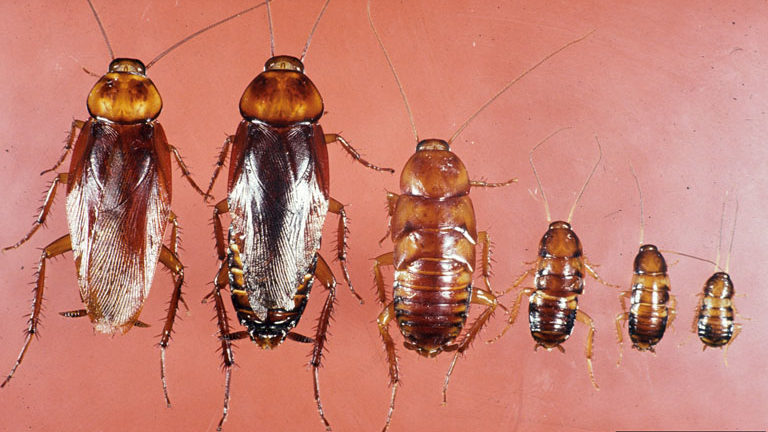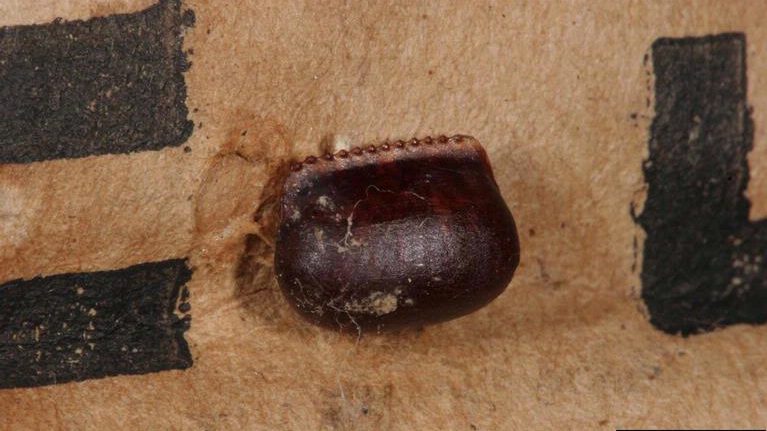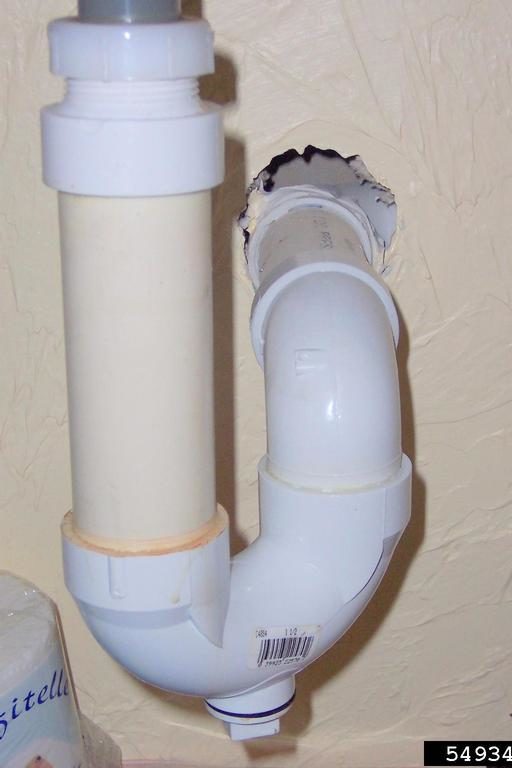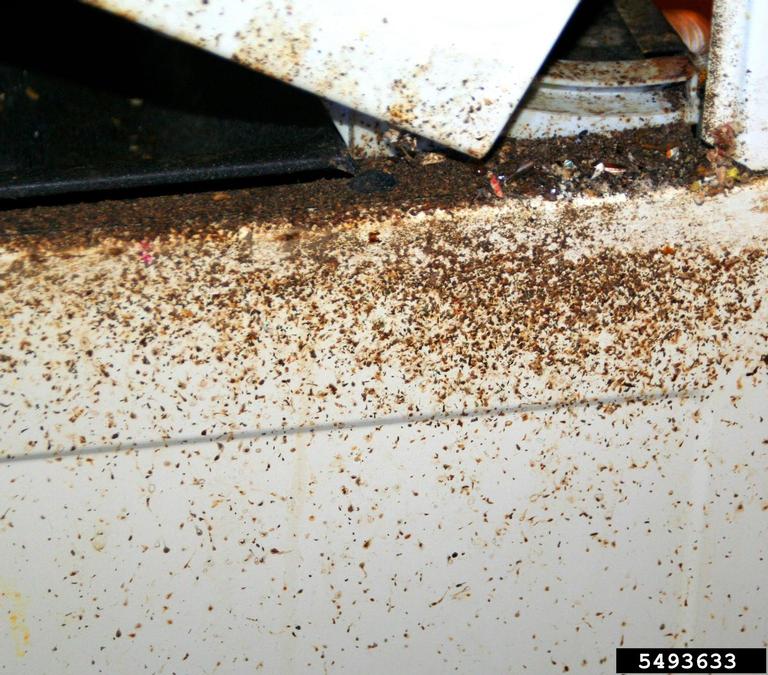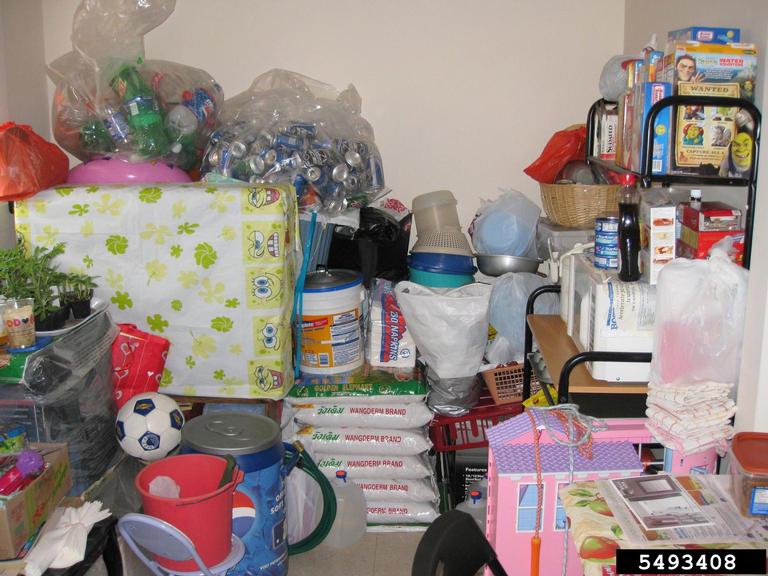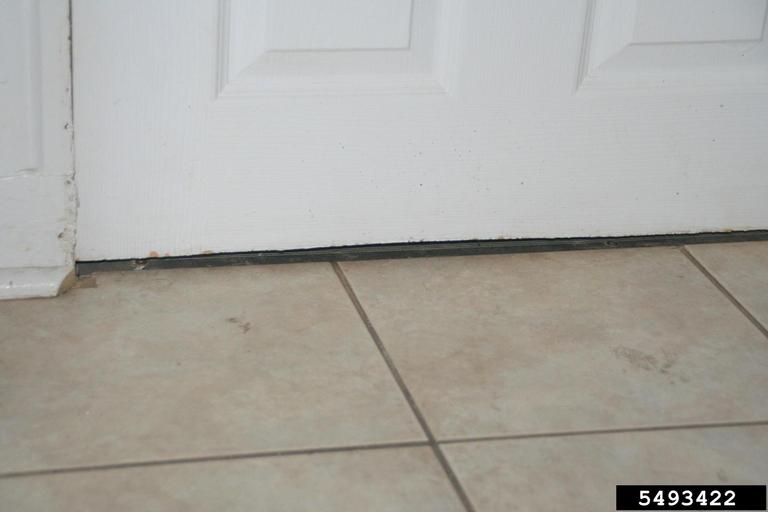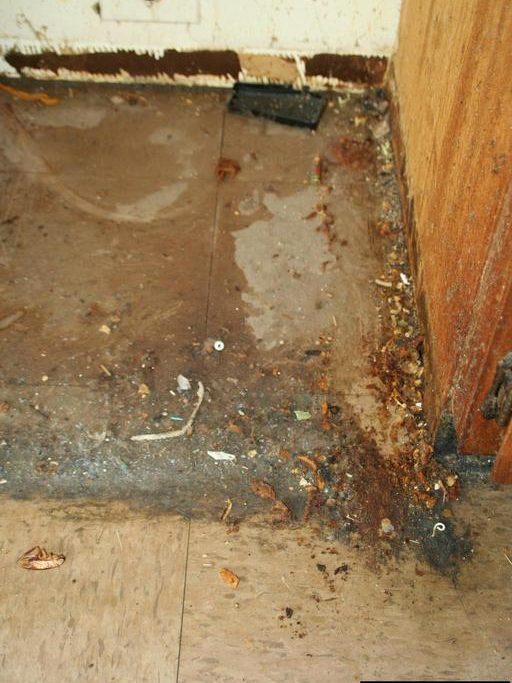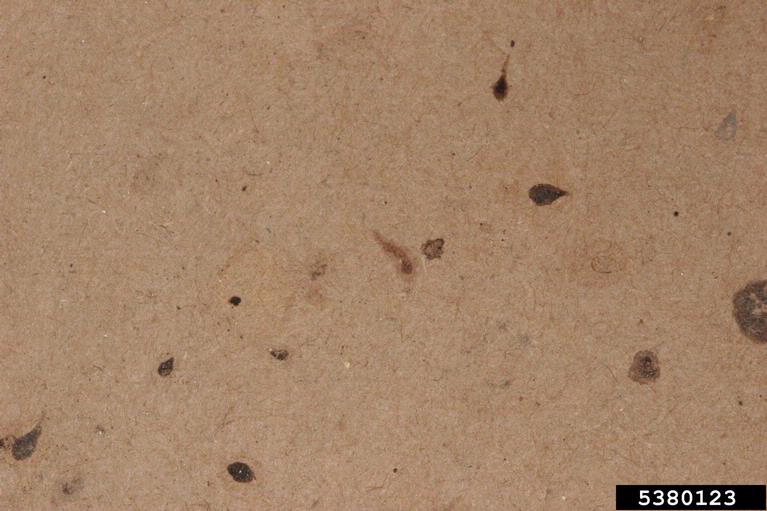Common name: Cockroaches
Author(s): Dan Suiter, Brian Forschler, Lisa Ames, Richard Hoebeke, University of Georgia, 2022
Content in this post is modified from the Management of Insect Pests in and Around the Home, University of Georgia Extension Bulletin 1412
Description
Cockroaches are large, night-active, fast-moving insects with a broad, flattened body, long antennae, and a relatively small head. The front pair of wings (called tegmina) are tough, protective, and lay on top of the membranous hind wings. Most cockroaches are poor fliers. None of the cockroach species listed below is indigenous to the U.S., but all are well established.
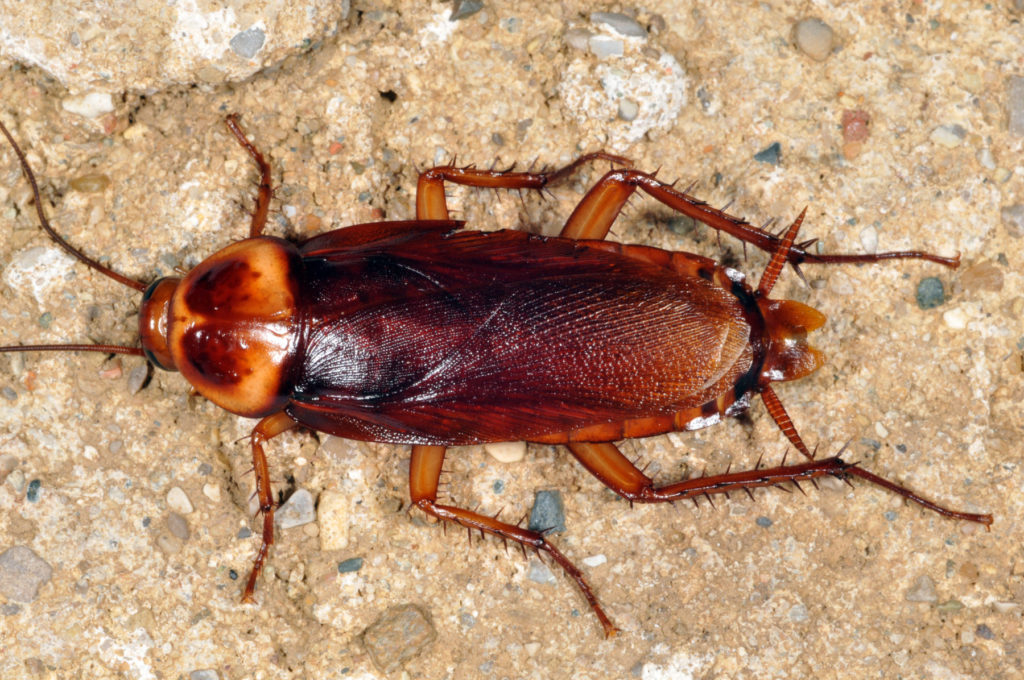
American cockroach (Periplaneta americana):
Adults are large (2 inches) with pale outer margins on the pronotum (upper thorax). Chestnut to light brown-colored insects that run quickly. Males and females are visually indistinguishable, although females are a little wider posteriorly than males.
Habits: Mainly found in sewers and other dark, damp hideaways such as basements. Rarely, if ever, found in attics. Night active. Sometimes found co-habiting outdoor harborage sites with smokybrown and/or Oriental cockroaches.
Interventions: Apply gel baits (multiple small dabs no larger than a pea) or broadcast granular baits in areas where cockroaches are found. Bait stations can be used to control small nymphs, but adults and large nymphs may be too big to fit into the small openings in most bait stations.
Might Be Confused With: smokybrown cockroach, Oriental cockroach.
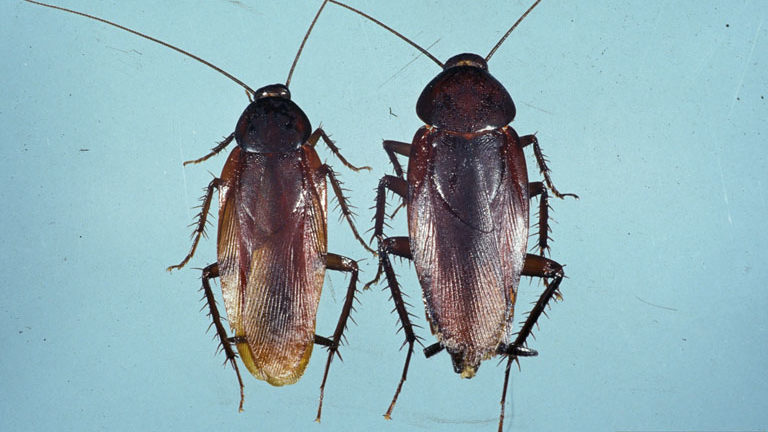
Smokybrown cockroach (Periplaneta fuliginosa):
Adults are large (1.5 inches) and uniformly dark cherry to dark red colored. Males and females are visually indistinguishable, although females are a little wider posteriorly than males. First instar nymphs are approximately 1/8 to 3/16 inch, and identified by the white band across their back, just behind the thorax, and a white band on the tip of the antennae.
Habits: Most common cockroach in suburban, Southern neighborhoods with mature hardwood trees present, where they commonly live in tree holes, attics, crawlspaces, sheds and similar harborages with high humidity and protected from the desiccating effects of wind. Not commonly found in kitchens, as is the German cockroach. Night active. Sometimes found co-habiting outdoor harborage sites with American and/or Oriental cockroaches. Rarely, if ever, found in sewers. First instars are not very mobile; their presence suggests a nearby egg case hatch.
Interventions: Apply gel baits (multiple small dabs no larger than a pea) or broadcast granular baits in areas where cockroaches are found. Bait stations can be used to control small nymphs, but adults and large nymphs may be too big to fit into the small openings in most bait stations.
Might Be Confused With: American cockroach, Oriental cockroach.
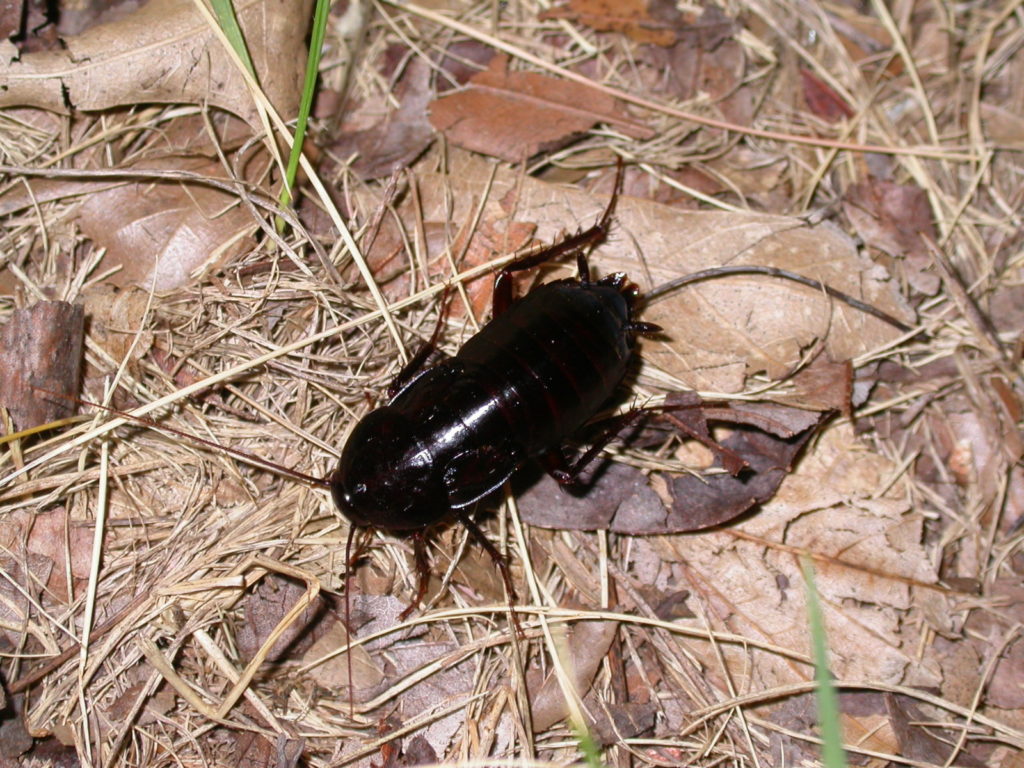
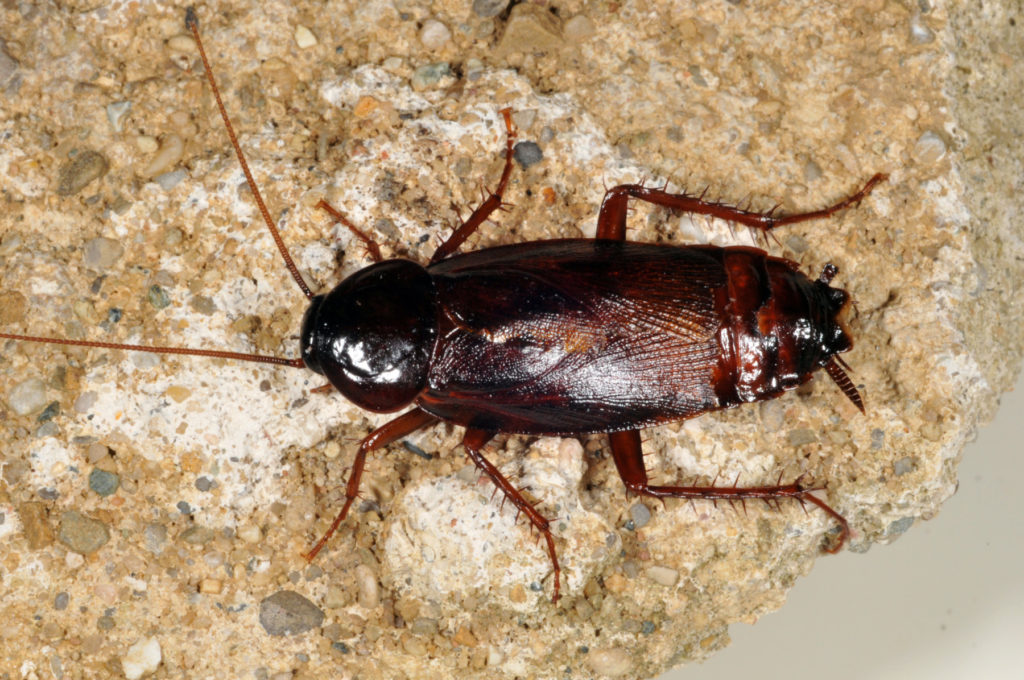
Oriental cockroach (Blatta orientalis):
Adults are large (1 to 1.25 inches) and cherry to black colored. Males with short wings that do not completely cover the abdomen; females wingless (wingpads only).
Habits: Sometimes found cohabiting in outdoor harborage sites with smokybrown and/or American cockroaches. Night active. Rarely found around homes in suburban environments. Biology and habits are more similar to the American cockroach than the smokybrown cockroach.
Interventions: Apply gel baits (multiple small dabs no larger than a pea) or broadcast granular baits in areas where cockroaches are found. Bait stations can be used to control small nymphs, but adults and large nymphs may be too big to fit into the small openings in most bait stations.
Might Be Confused With: smokybrown cockroach, American cockroach.
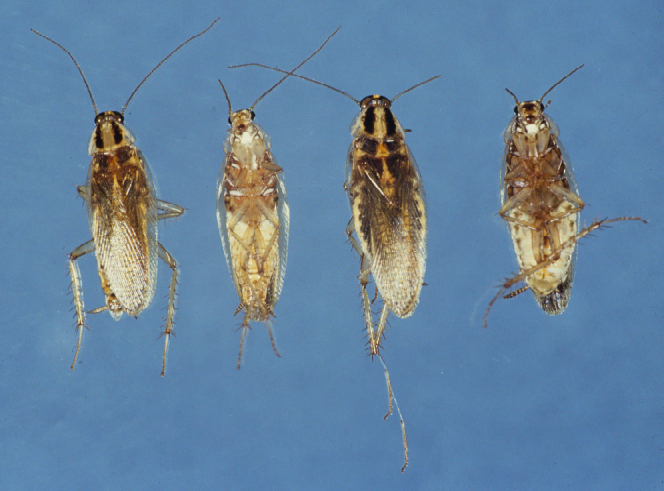
Asian cockroach (Blattella asahinai):
Adults of both sexes about 1/2 to 5/8 inch, tan colored with dual, parallel stripes on back of pronotum (upper thorax). Males and females are visually indistinguishable. Adults of the Asian cockroach are extremely similar, almost identical, to those of the German cockroach. Generally speaking, Asian cockroach adults have longer and narrower wings than those of German cockroaches. Asian cockroaches are also generally found outdoors, whereas German cockroaches are found indoors.
Habits: Attracted to light, readily flies (rare for a cockroach), and found in shaded areas outdoors with leaf litter, mulch and/or high grass present. Rarely found indoors, unless attracted there by light. Flies during the day in response to disturbance (walking through habitat).
Interventions: Alter lighting to make structure less attractive at night (see section on Proactive Pest Management). Broadcast granular bait in areas where cockroaches are found. If desired, apply an appropriately labeled residual spray to those areas where cockroaches are found.
Might Be Confused With: German cockroach.
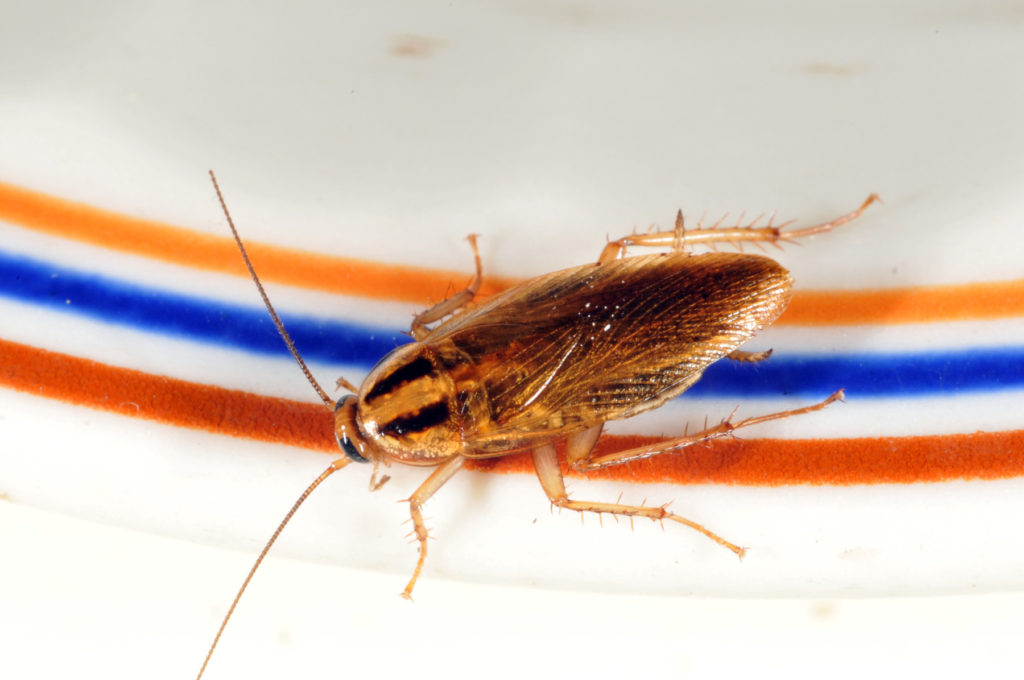
German cockroach (Blattella germanica):
Adults of both sexes about 1/2 to 5/8 inch, tan colored with dual, parallel stripes on back of pronotum (upper thorax). Males and females are visually indistinguishable.
Habits: Obligate indoor pest, never to rarely found outdoors except in cases of extreme indoor infestations. Found mainly in kitchens near and in warm appliances and sources of water. Night active. Under extreme levels of infestation, this cockroach may be responsible for allergies, especially in children.
Interventions: Use pheromone-based sticky traps to highlight areas of activity. Use gel baits and bait stations in areas (mainly in the kitchen under the sink, next to the garbage, under/next to the refrigerator and stove, and in infested drawers) where German cockroaches are found. In moderate to heavy infestations, as many as 12-15 bait stations may be needed in a standard-sized home. Place bait stations on flat surfaces in corners and along the edges of walls. When using gel baits, the application of many small bait ‘spots’ is preferred to the application of a few large bait spots (it does not take much bait to affect a large number of German cockroaches). If desired, in cases of extreme infestation apply a spot treatment with an appropriately labeled residual spray inside cracks and crevices where cockroaches are found. Total release aerosols (bug bombs) are ineffective at controlling German cockroaches, and should not be used indoors.
Might Be Confused With: Asian cockroach.
Proactive Pest Management
The origin and extent of a pest infestation is often associated with one or more conditions that promote the survival and reproduction of that particular pest. Those conditions are often referred to as life support requirements, and include:
➤ Favorable temperatures ➤ Abundant food and water ➤ Available shelter/harborage
Food: General rules of cleanliness during food preparation, storage and disposal is the logical starting point for helping to resolve and prevent certain pest problems.
Shelter: Shelter, also referred to as harborage, is simply a place where insects reside, rest, or hide. Specific locations become harborage because that site provides features that promote pest survival. Preferred pest harborage sites are usually protected from air movement (and its desiccating effects) and predators. They also include areas where food and water is abundant or easily accessible, and where temperatures are stable (no wide fluctuations) and optimum. When possible, pest-friendly harborages should be eliminated or pest access denied.
Outdoor harborages: Include treeholes, areas in and under fallen trees and limbs, leaf litter accumulations, and mulch and associated yard debris. In treeholes, cockroaches, ants, mosquitoes, and a number of other pests find a harborage characterized by moist air, darkness, and protection from the desiccating effects of wind and extreme fluctuations in temperature.
Exterior vegetation, combined with elements related to their maintenance (mulch and irrigation), can provide pests with harborage and should be kept away from the foundation and exterior doors. Property owners should limit the use of groundcovers, shrubs, vines, and deep mulch beds near the foundation of their home. These landscape features retain moisture in the soil, and thereby expand potential pest harborage areas. Mulch creates conditions that certain pests need to thrive by providing food, water and shelter. Excessive mulch provides decaying organic matter, fungi, and molds that are the food source for many small insects which then attract predatory pests such as ground beetles, spiders, and scorpions. Mulch near the home should be limited to a depth that maintains soil moisture required by the landscape plants. Groundcovers should be kept at least 1.5 feet from the foundation walls.
Man-made harborages: Include, for example, the areas underneath boards, patio stones, potted plants, garden statues, decorative rock piles, garden barriers, and other flat items lying on the ground. Keeping such garden decorations away from the foundation and exterior doors will reduce
the potential for pests to harbor near the home and thus their chance of entering.
The structure itself can be viewed as a nearly endless series of man-made voids, behind cracks and crevices, that can serve as harborage for pests. Any crack or crevice in a structure that leads to a void will invite certain insect pests to harbor in that space, especially if food and water are available or the space enhances survival and growth.
Structural harborages can be made unusable by sealing cracks, crevices and other entryways. Clutter inside homes also provides harborage, and sometimes food, for pests. Clutter can be defined as persistent piles of clothing, books, paper bags, boxes, papers and newspapers, recyclables, etc.
Water: Excessive, persistent moisture is the most important condition allowing many types of pest infestations to establish and persist. Not only is water critical to the health and normal metabolism of all forms of life, but its abundance also leads to the growth of various molds, fungi, and other microorganisms which are the primary food source for numerous insect species. Property owners should ensure that rainwater flows away from their home by examining the grade or slope of the landscape to make certain it is appropriate; that gutters, downspouts, roof, and air conditioner condensate drainage patterns are operating properly and depositing water away from the foundation; that attics, crawlspaces, and basements are properly ventilated; that a vapor barrier is in place in the crawlspace; that sprinklers are positioned properly, and there is no standing water or persistent wet spots next to the foundation or in the crawlspace.
Other Practices: Homeowners can do other things to keep pests from entering the home, such as installing doorsweeps on all exterior doors, screens on all windows, ensuring that doors and windows are well-sealed when closed, and that all foundation and attic vents are adequately screened, sealed and operating properly
Reactive Pest Management
Baits are pesticide products that are effective only after being eaten by the pest. They are formulated with the active ingredient incorporated into a food source that is palatable and preferred by the target pest species. Baits are generally designed to be specific to only one or a few types of pests, are often sold in ready-to-use containers, and are to be placed, according to the label, in specific areas. Bait formulations are therefore considered more environmentally-sensitive than other pesticide formulations. Over-the-counter bait products are generally limited to ant, cockroach, rat, and mouse control, and can typically be used both inside and outside the home. Over-the-counter market baits might be available in the form of gels, pastes, liquids, pellets, granules, or blocks and are ready-to-use, according to label instructions, when purchased.
Additional information about insecticides, including definitions, formulations, information about how to interpret product labels and material safety data sheets (including principles of toxicity), safety, and insecticide mode of action (i.e., how insecticides work) can be found in University of Georgia Extension Bulletin #1352, Insecticide Basics for the Pest Management Professional, and Extension Circular #998, Pesticide Safety for the Homeowner, at caes.uga.edu/publications.
Additional Bugwood.org Images
